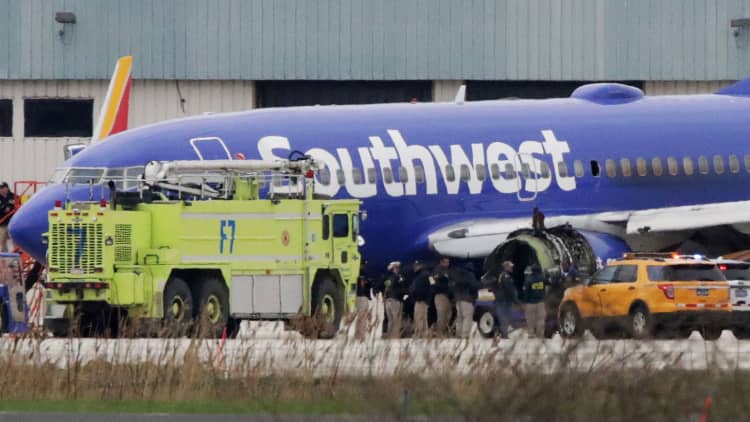
Regulators last year proposed more rigorous testing of the type of engine that exploded on a Dallas-bound Southwest Airlines flight on Tuesday.
The suggested regulation is still working its way through the rulemaking process.
One passenger was killed when the explosion caused shrapnel to cut into the Boeing 737-700's fuselage, blowing out a window, depressurizing the cabin. Passengers aboard Southwest Flight 1380 had rushed to pull the victim back into the plane after she was partially sucked out of a window, witnesses said.
It was the first fatality on a U.S. airline since the 2009 Colgan Air crash near Buffalo, New York.

The CFM56-7B, the engine involved in Tuesday's incident, is one of the most common in the world. It powers some 6,700 aircraft around the world, according to its manufacturer CFM International, a joint venture of General Electric and France's Safran Aircraft Engines.
Southwest said it was its first on-board fatality related to an incident or accident in its history.
The Federal Aviation Administration sought more rigorous testing of the engine last August, when it proposed a rule that would subject the engines to ultrasonic tests of their fan blades. Late Wednesday, the FAA said it would issue a rule within two weeks requiring such tests.
"Any blades that fail the inspection will have to be replaced," said the FAA.
On Aug. 27, 2016, a Southwest flight made an emergency landing in Pensacola, Florida, after a fan blade separated from the disc, according to the National Transportation Safety Board. Debris punched a 16-inch by 5-inch hole in the left fuselage, above the wing, the NTSB had said.
In both incidents what occurred is known as uncontained engine failure. Engines are designed with special casings that are intended to keep blades and other metal from flying out and potentially striking the fuselage of the plane. Engine manufacturers put them through rigorous testing to make sure blades and other metal can be contained.
Southwest late Tuesday said that it would accelerate testing of CFM56 engines "out of an abundance of caution" and that the ultrasonic checks of the engines' fan blades would likely be completed within 30 days. Several other airlines using this engine made similar announcements.
GE and Safran are deploying technicians to support Southwest's inspection program. In a statement, GE said it also is supporting the effort of the NTSB and Southwest as they investigate the cause of the accident.
"By law, CFM cannot provide information about the accident or details related to it. You may contact the NTSB for updates," the manufacturer said in a statement. "The members of the CFM Team worldwide wish to express their deepest condolences to family of the victim of this incident.



